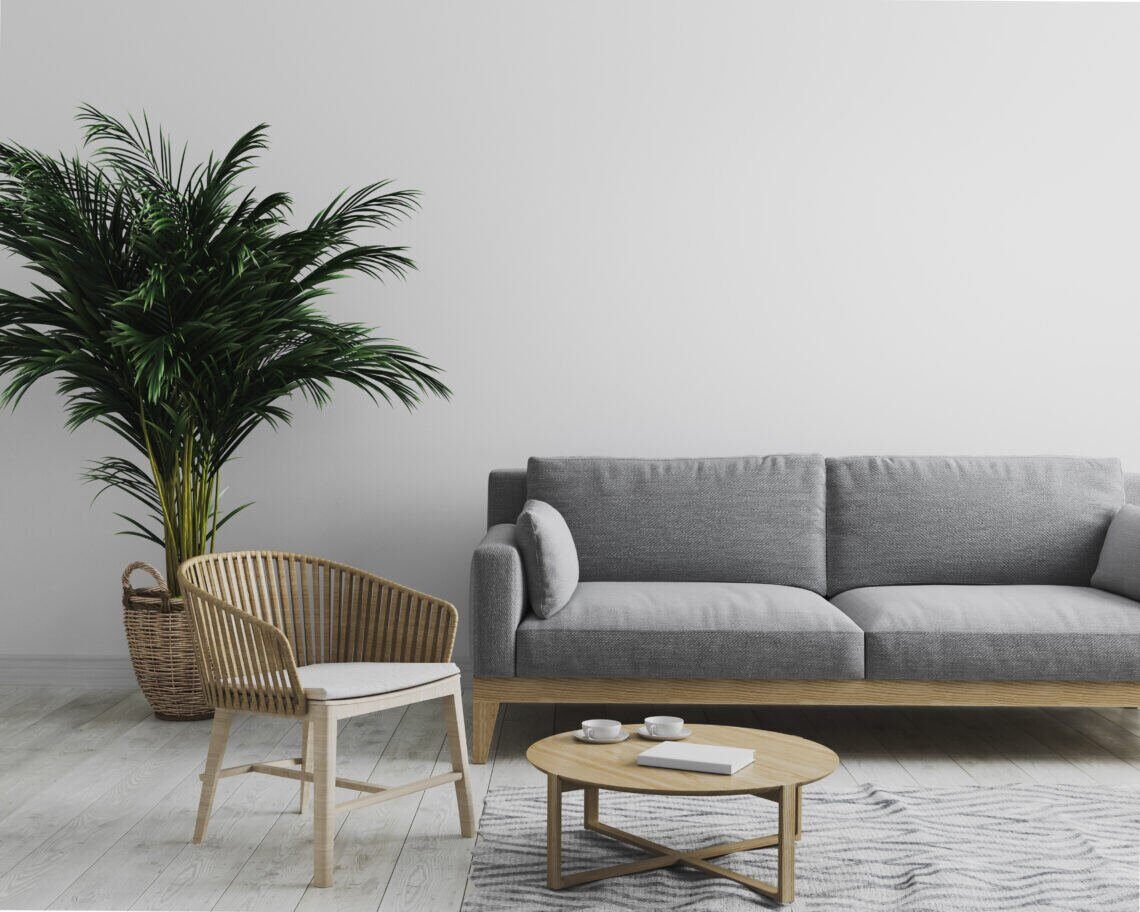Life changes, shouldn’t your furniture change with it? We’re here to explore the option of rent-to-own furniture and whether it’s a good idea for those living in a rental home.
Rent-to-own furniture can have both advantages and disadvantages, and whether it’s a good idea depends on your individual circumstances and priorities.
How does Rent-to-Own Furniture Work?
Rent-to-own furniture, also referred to as lease-to-own furniture, is available at various rent-to-own stores offering a wide range of products, including large items such as beds and sofas, as well as smaller items like home decor and appliances.
Similar to a regular furniture store or outlet, you go in and buy your desired pieces taking them home the same day. However, with RTO you pay off your furniture in installments. While opening a credit card in traditional stores requires a credit check, rent-to-own stores don’t typically require a credit check.
After selecting your furniture, you’ll sign a contract that will be renewed on a weekly or monthly basis until the item is paid off. At the end of each rental period, you can decide if you want to keep the item and renew the lease or return the item. So, if your rental home lease is expiring and you’re planning to move, you can easily opt out of the contract and return the furniture. On the other hand, if you find the piece works for you, you can keep renewing and at the end of the lease, the item will be yours.
What Type of Furniture Can I Rent?
Rent-to-own stores typically offer a wide range of furniture options to meet customers’ needs. While it may vary based on the store and its inventory, you can generally find furniture and accessories for every room in your home, including sofas, coffee tables, TV stands, entertainment centers, beds (including mattresses), bedroom sets, dining tables and chairs, desks, kitchen tables and chairs, outdoor seating and dining sets, and more!
Is Rent-to-Own Furniture More Expensive?
Rent-to-own furniture can be more expensive compared to purchasing furniture outright or even using traditional financing options. The primary reason for this is the added convenience and flexibility offered by rent-to-own agreements.
When renting furniture from a rent-to-own store, you typically make monthly payments over a specified period. These payments usually include the cost of the furniture plus additional fees and charges such as delivery, setup, and maintenance. Over time, these payments can add up and result in a higher overall cost compared to buying the same furniture upfront.
Another factor contributing to the higher cost is the interest or finance charges associated with rent-to-own agreements. Rent-to-own stores often charge higher interest rates than traditional lenders, which increases the total amount you’ll pay over the rental period.
However, rent-to-own options can be beneficial for individuals who may not have the upfront funds or credit history to purchase furniture outright. They provide an opportunity to acquire furniture with more flexible payment terms and without the need for a large upfront payment.
Before entering into a rent-to-own agreement, it’s important to carefully review the terms, fees, and interest rates to determine if it aligns with your budget and financial goals. Additionally, exploring other financing options or saving up to purchase furniture outright may be more cost-effective in the long run.
Advantages of Rent-to-Own Furniture
Accessibility: Rent-to-own furniture allows you to acquire furniture without a large upfront payment or credit check, making it more accessible for those with limited financial resources or poor credit history, as well as those needing furniture on a budget. In addition, you can typically get the furniture you need the same day. This is especially convenient when you’re moving into a new rental home and need furniture immediately.
Flexibility: Renting furniture can provide flexibility, as you can typically return or upgrade the items if your needs or preferences change. This can be particularly useful for temporary or transitional living situations as renters never know what the next floor plan will look like, what ceiling heights will be, door placements and all the factors that come into play when outfitting a new home.
Maintenance and repairs: Rent-to-own agreements often include maintenance and repair services, which means you won’t have to worry about fixing or replacing damaged furniture. This can be a huge relief for those who are on a budget, as it can alleviate financial and emotional stress.
Disadvantages of Rent-to-Own Furniture
Cost: Lease-to-own furniture is generally more expensive in the long run compared to buying furniture outright, though that is certainly not always the case. The total amount you pay over the rental period can significantly exceed the item’s retail price. However, if you know you won’t be in a rental home for a lengthy period of time, it may not make sense to invest in a piece you won’t be able to use in the near future.
Interest and fees: Rent-to-own agreements often involve high interest rates and additional fees, which can further inflate the overall cost of the furniture. Again, this may be worth it if you know your rental home situation will change and you’ll need new or different pieces all together.
Ownership delays: Until you complete all the payments and exercise the purchase option, you don’t officially own the furniture. This means you may have limitations on customizing, selling, or moving the items.
Credit impact: Some rent-to-own agreements don’t contribute positively to your credit history. If improving your credit score is a priority, it may not be the best option.
Before deciding whether rent-to-own furniture is a good idea, carefully evaluate your financial situation, long-term goals, and the specific terms of the agreement. Consider alternative options such as saving up to buy furniture outright, exploring financing options, or purchasing second-hand items.
What Should I Consider with Rent-to-Own Furniture?
Renting furniture when you already live in a rental home can present some additional considerations. Here are a few points to think about when deciding whether to rent-to-own furniture in a rental home:
Length of stay: If you anticipate staying in your rental home for a short period, it might not be cost-effective to rent-to-own furniture. Consider the duration of your lease and whether the cost of renting the furniture for that period outweighs the benefits.
Compatibility: Rental homes often come with pre-existing furniture or may have limitations on modifications. Ensure that the furniture you rent is compatible with the space and aligns with any guidelines or restrictions set by your landlord.
Mobility: If you anticipate moving frequently in the future, it may be more practical to have flexible options for your furniture. Rent-to-own furniture allows you to easily return or upgrade items, making it convenient for people with a mobile lifestyle.
Cost-benefit analysis: Evaluate the total cost of renting furniture over the rental period compared to the cost of purchasing furniture outright. Consider whether the convenience and flexibility of rent-to-own outweigh the potential extra expenses.
When is Rent-to-Own Furniture a Good Idea?
Rent-to-own furniture can be a good idea in certain situations. Here are a few scenarios where it may be beneficial:
Limited upfront funds: If you need furniture but don’t have the immediate funds to make a large upfront purchase, rent-to-own can provide a more accessible option. It allows you to acquire the furniture you need and pay for it in affordable monthly installments.
No credit or poor credit history: Rent-to-own stores often have more lenient credit requirements compared to traditional financing options. If you have no credit history or a poor credit score, rent-to-own can be a viable option to obtain furniture without a credit check or a significant impact on your credit score. This is especially true when you’re in need of a costly or big-ticket item like a couch or bedroom set.
Temporary or short-term needs: If you’re in a temporary living situation, such as renting a furnished apartment or planning to move in the near future, renting furniture on a short-term basis can be convenient. Rent-to-own allows you to furnish your space without the commitment of long-term ownership or the hassle of selling or moving furniture later. This also allows you to rent pieces that may be specifically tailored to your current space but may not work in your next rental home.
Try before you buy: Renting furniture can give you the opportunity to test it out and see if it fits well in your space or meets your comfort requirements. If you’re unsure about a particular furniture item, rent-to-own allows you to “try before you buy” and decide if it’s a good long-term investment.
Flexibility and convenience: Rent-to-own agreements often come with added services like delivery, setup, and maintenance. If you value convenience and prefer to have these services bundled with your furniture rental, it can be a convenient option.
It’s important to carefully consider your financial situation, budget, and long-term plans before entering into a rent-to-own agreement. Assess the total cost, interest rates, and fees associated with the rental to ensure it aligns with your financial goals. Additionally, comparing other financing options and weighing the overall cost is crucial to make an informed decision.
Whether you choose to purchase your furniture outright or rent-to-own, consider all contributing factors including your living situation as well as your financial obligations and limitations. It’s also important to remember that you can invest in pieces you know will work while utilizing rent-to-own to test other pieces or to rent an item you know won’t work in another rental home.
To learn more about rent-to-own options with SimplyHome homes for rent and how residents can receive discounts with Rent-A-Center and CORT through the Resident Benefit Program, contact SimplyHome by Camillo today.

.png?width=435&height=108&name=SimplyHome_logo_horiz_white%20(2).png)


.png?width=352&name=Featured%20Blog%20Images%20(1).png)

